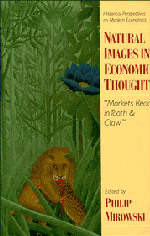Freshly Printed - allow 6 days lead
Couldn't load pickup availability
Natural Images in Economic Thought
Markets Read in Tooth and Claw
This 1994 book was the first collection devoted to impact of natural sciences on content and form of economics in history.
Philip Mirowski (Edited by)
9780521443210, Cambridge University Press
Hardback, published 29 July 1994
636 pages, 10 b/w illus.
22.9 x 15.2 x 4 cm, 1.1 kg
"...I recommend this volume to anyone interested in a lively debate about the intellectual cross-pollination between the natural and social sciences. Many of the essays are provocative." John C. Moorhouse, Reason Papers
This 1994 collection of interdisciplinary essays was the first to investigate how images in the history of the natural and physical sciences have been used to shape the history of economic thought. The contributors, historians of science and economics alike, document the extent to which scholars have drawn on physical and natural science to ground economic ideas and evaluate the role and importance of metaphors in the structure and content of economic thought. These range from Aristotle's discussion of the division of labour, to Marshall's evocation of population biology, to Hayek's dependence upon evolutionary concepts, and more recently to neoclassical economists' invocation of chaos theory. Resort to such images, contributors find, was more than mere rhetorical flourish. Rather, appeals to natural and physical metaphors serve to constitute the very subject matter of the discipline and what might be accepted as the 'economic'.
List of contributors
Acknowledgements
Part I. The Natural and the Social: 1. Doing what comes naturally: four metanarratives on what metaphors are for Philip Mirowski
2. So what's an economic metaphor? Arjo Klamer and Thomas C. Leonard
Part II. Physical Metaphors and Mathematical Formalization: 3. Newton and the social sciences, with special reference to economics, or, the case of the missing paradigm I. Bernard Cohen
4. From virtual velocities to economic action: the very slow arrivals of linear programming and locational equilibrium Ivor Grattan-Guinness
5. Qualitative dynamics in economics and fluid mechanics: a comparison of recent applications Randall Bausor
6. Rigor and practicality: rival ideals of quantification in nineteenth-century economics Theodore M. Porter
Part III. Uneasy boundaries between man and machine: 7. Economic man, economic machine: images of circulation in the Victorian money market Timothy L. Alborn
8. The moment of Richard Jennings: the production of Jevons's marginalist economic agent Michael V. White
9. Economics and evolution: Alfred James Lotka and the economy of nature Sharon E. Kingsland
Part IV. Organic Metaphors and their stimuli: 10. Fire, motion, and productivity: the proto-energetics of nature and economy in François Quesnay Paul P. Christensen
11. Organism as a metaphor in German economic thought Michael Hutter
12. The greyhound and the mastiff: Darwinian themes in Mill and Marshall Margaret Schabas
13. Organization and the division of labor: biological metaphors at work in Alfred Marshall's Principles of Economics, Camille Limoges and Claude Ménard
14. The role of biological analogies in the theory of the firm Neil B. Niman
15. Does evolutionary theory give comfort of inspiration to economics? Alexander Rosenberg
16. Hayek, evolution, and spontaneous order Geoffrey M. Hodgson
Part V. Negotiating over Nature: 17. The realms of the Natural Philip Mirowski
18. The place of economics in the hierarchy of the sciences: Section F from Whewell to Edgeworth James P. Henderson
19. The kinds of order in society James Bernard Murphy
20. Feminist accounting theory as a critique of what's 'natural' in economics David Chioni Moore
Index.
Subject Areas: Economic theory & philosophy [KCA]


